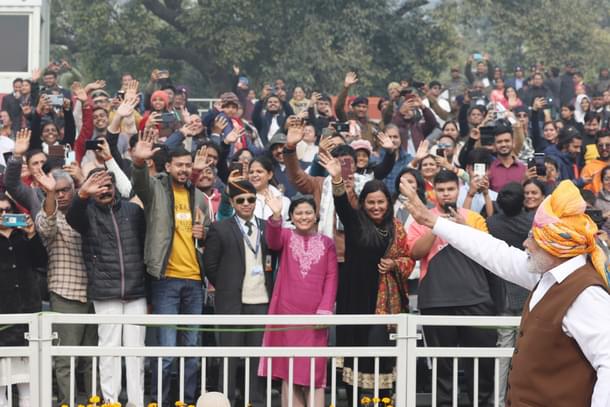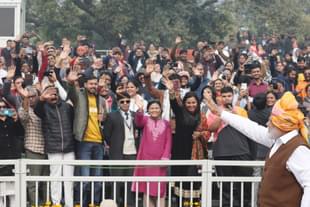Commentary
An Air Of Confidence: How The Context To 2024 Elections Is Different From Previous Lok Sabha Polls This Century
Pratim Ranjan Bose
Jan 29, 2024, 05:43 PM | Updated Aug 13, 2024, 03:46 PM IST
Save & read from anywhere!
Bookmark stories for easy access on any device or the Swarajya app.


If Narendra Modi wins the 2024 election – which is expected – to equal Jawaharlal Nehru’s record for a consecutive third term, the credit should go to a Confident India. This outlook is distinctly separate even from 2019, when he was elected for a second term.
Lest there be any doubt, Modi has worked hard for this. Over the last five years, his government has delivered on both emotive and economic fronts. For the first time, India is a shining star amidst global distress.
The government is stable and popular even after 10 years in office. The economy is growing at the fastest pace among global peers and India is taking confident steps in domestic and foreign policy fronts.
But such a confidence as now was absent in the past. When the Atal Behari Vajpayee government went to polls in 2004, it was only the start of a boom phase and its premature 'India Shining' campaign crashed and burned.
Boom and bust - the 2009 context
That boom lasted till 2007 and growth bounced back in 2009 - after the meltdown in 2008 - when the Manmohan Singh government of Congress-led United Progressive Alliance (UPA) was re-elected.
However, the confidence was missing.
Firstly, Indian growth was fuelled by both the subprime-led boom in the US and, a roaring Chinese growth engine. India grew fast. But China grew faster.
Not just that, the world was banking on China to recover from the meltdown. The George W.Bush administration literally begged China to stay invested in the US treasury bonds.
“U.S. Treasury Secretary Henry Paulson praised China's cooperation in taming global financial turmoil and urged the next U.S. president to continue an active economic dialogue with Beijing,” The New York Times reported on October 22, 2008.
Meanwhile in India, a political crisis and the global meltdown came together. The UPA survived a trust-vote, due to differences within, weeks before the credit crisis erupted the US.
The UPA government was re-elected but under the looming shadow of corruption and mismanagement. The 2G spectrum scam broke out in 2007, followed by illegal iron ore mining controversy in 2008.
The next five years were downhill. Irregularities in coal block allotment, shortage of fuel, controversies on power purchase agreements, a huge scam in Commonwealth Games organisation and others.
Banks were struggling with rising pile of bad debts and curbed lending, power plants were idling, infrastructure building came to a grinding halt, road contractors went bankrupt and, an inept government was counting its days.
The 2019 scenario
The backlog of the past, shocks from structural reforms like goods and services tax (GST), demonetisation, and the collapse of IL&FS leading to a liquidity-crunch, clouded the economic outlook in 2019 election when Modi was elected for the second term.
The context to 2024
Everything has changed in the last five years which were marked by a once-in-a century pandemic and conflicts in global politics and economics. The world economy was never as uncertain since World War-II.
In this new world, China and the entire developed West are faltering. The damage to the world economy is deep and, there is high possibility that the next five years will belong to India.
The leadership
The Narendra Modi government deserves full credit for protecting national interests so well over the last five years that Indians could barely feel the storm outside.
Looking back, our pains were limited mostly to the nationwide lockdown - that shrunk the gross domestic product (GDP) by 24 percent in June 2020 quarter – and the human tragedies during the delta wave in early-2021.
A comparative study will reveal that the US, Europe, Japan, faced more intense and repeated outbreaks, per capita deaths, and disruption in supplies of essentials. A complacent Korea ended up suffering from vaccine crisis.
Covid had spread around the world from China. The country remained under lockdown for nearly two years. There was much hype about Beijing’s vaccination programme. In the end, their own vaccines proved inefficient.
India faced covid-19 outbreak with rudimentary public infrastructure and everyone expected India to suffer the worst globally. In the end, from food distribution to vaccination, India did better than others. It also helped nearly 100 countries with over 16 crore (160 million) doses of vaccines.
According to ‘Down To Earth,’ India had barely 183 labs – 132 government 51 private - to test covid-19, in March 2020. We now have nearly 3,400. Few hospitals had oxygen plants back in 2021. Now there are too many.
It is not merely building infrastructure but building it quick, that mattered. Our e-commerce and digital payments system kept the supplies moving. The digital infrastructure did wonders in an efficient roll-out of vaccination.
The economy bounced back from the September 2020 quarter and, since then there was no going back. India’s inflation-adjusted real gross domestic product (GDP) grew by a record 8.1 per cent between April 2021 and September 2023.
Considering the supply chain disruption, volatility in energy prices, heightened geopolitical contests, unending conflicts and near collapse of the UN trade architecture – things were not supposed to be that smooth. The US and UK are still suffering.
It is far from smooth in China where the economy is spluttering despite massive government stimuli. Domestic consumer sentiments are at a 25-year low. Investors are leaving, and Chinese are fleeing the country in record numbers.
In the first half of 2023, over 1,20,000 Chinese citizens sought asylums in foreign countries. The annual number of asylum seekers was 25,000 in 2013. The frustration of common Chinese is at unprecedented high since the opening up in 1978.
New energy
This is not to imply that everything was or is hunky-dory in India. Consumer confidence and job opportunities dipped in 2020 but since then it is only moving up and consistently so.
IT sector and start-ups entered a bumpy phase due to global reasons, but production and recruitments peaked in automobile and engineering. The campus recruitment of students from the core engineering disciplines peaked.
Private capital expenditure is back after a decade, alongside high state investments in infrastructure. Our highway, railway, port, and airport infrastructure were never as good and, we are getting better.
We are at least two decades behind China on the investment curve. But the arrival of Apple, GE and other top-notch brands is proof that we have finally arrived as a global investment destination.
And we did it with democracy. India conducted state elections on schedule even during the pandemic-hit 2020 and 2021. BJP lost some of them. But democracy gained confidence.
In summary, India did extraordinarily well on all fronts. Unforeseen circumstances apart, the economy is well poised to enter higher growth trajectory after the election that will start in the next two months.





